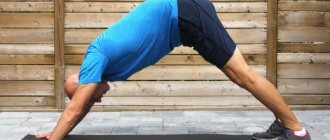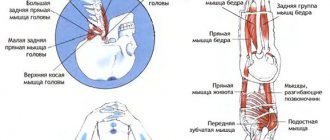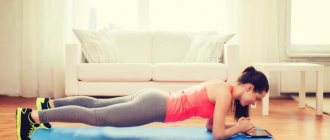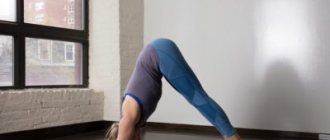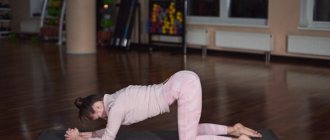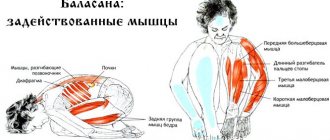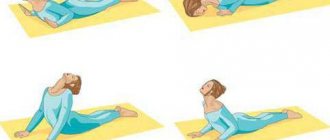Execution technique
Doing it correctly affects the effect the practice will have. Either positive or not at all. As with all other exercises, it is important to monitor technique and breathing, concentrate and relax. How to do it correctly?
- First, you need to sit in Vajrasana pose (a pose in which a person sits on his heels with his knees bent) and spread his knees to the sides.
- Straighten your arms, place your palms under your hips, and pull your elbows back.
- The eyes should be open, as in Shambhavi mudra (the gaze is directed to the area between the eyebrows), and the mouth should be closed.
- Breathe slowly and deeply through your nose. At the end of the inhalation, stick your tongue out of your mouth as much as possible, but so that it does not cause discomfort.
- Reach the chin with the tip of your mouth. Exhale also slowly, making a low sound “aaa”. You can't strain your throat. At the end of the exhalation, close your mouth and breathe through your nose again.
Reference! This is one whole cycle. Repeat it as many times as you have the opportunity to do. When treating a throat, it is useful to do about 5-10 cycles.
Additional information about Yoga 23 style
- “Hatha Yoga. Conceptual sketch" by A. Sidersky
- “Yoga of eight circles” A. Sidersky
- “The Third Discovery of Power” A. Sidersky
- “The Teachings of Don Juan” by C. Castaneda, books 2-10
- “Yoga Therapy” by Sri Swami Sivananda with comments by A. Sidersky
- Books on the practice of Tensegrity: "The Gift of the Nagual - I", "The Gift of the Nagual - II" and "The Gift of the Nagual - III"
- "The Metaphysics of Hatha Yoga" by Lucien Ferrer
- "Quantum Psychology", "Illuminatus" R. Wilson
- “Iron Shirt”, “Tao – the Path of Awakening” by Mantek Chia
Adviсe
When performing this exercise, follow these guidelines:
- do not throw your head back too far, otherwise the neck muscles will not be used, which will be bad. Pull it as high as you can;
- the tongue also needs to be extended to the maximum in order to feel the basal muscles;
- Stretch your fingers to relieve excess tension.
Important! Simhasana is a pose that can be performed at any time, but you should still not overeat before performing it.
The body should be comfortable. And not only yours. Make sure that the sounds you make do not disturb others. This pose may also interest young children. Imagine it as a game, they can try themselves in the role of a jungle animal, which makes the activity not only useful, but also fun.
Briefly about the author
A. Sidersky had serious problems with his spine as a child and even attended a special school for such children. But, apparently, his high sense of purpose and unwillingness to put up with pathology moved him in the right direction. From the age of six, he was steadily engaged in physical therapy and swimming using various methods, and already at ten, completely healthy, he transferred to a regular school and began to engage in competitive swimming.
Thanks to his deep understanding of the sport from the inside, he became interested in yoga as soon as he learned about it. Since then, he has been striving to create something useful for everyone who wants to be healthy, because he himself succeeded.
Benefits of exercise
This asana, when performed correctly and repeated regularly, provides positive benefits to the body, mind and spirit. What beneficial effects can this pose have on the physical level?
- throat treatment;
- prevention of respiratory diseases;
- reducing inflammation around the neck;
- improvement of voice, hearing aid;
- strengthening the muscle skeleton;
- fight stress, strengthen nerves;
- facial rejuvenation due to tension of the facial muscles.
On an emotional level:
- getting rid of accumulated fuss;
- mitigating stress levels;
- getting rid of unexpressed emotions and grievances when growling.
When is it beneficial to practice lion pose?
- the presence of a violation of the outflow of venous blood from the head;
- frequent colds and ARVI;
- for laryngitis, tonsillitis or pharyngitis;
- decreased oral immunity;
- for snoring;
- presence of neck pain.
Yoga against throat diseases
Lion Pose or Simhasana is one of those poses that causes mixed reactions. Yoga is associated with grace and grace, and this asana may seem funny. But, despite the comical effect, it is very effective for the treatment and prevention of various diseases of the throat and larynx.
Not many people dare to perform Simhasana in a group lesson, so it should be practiced at least at home. To get used to it, you need to perform the asana immediately after brushing your teeth. It will not take much time, and the body will gradually develop a habit and repeating the asana will become automatic.
The lion pose is recommended not only by yogis, but also by speech therapists and cosmetologists. It will be an excellent addition to physiotherapeutic procedures prescribed for people with chronic throat diseases.
Reasons for performing Simhasana:
- Treatment and prevention of nasopharyngeal diseases. Performing asana can reduce pain and slow down the inflammatory process. The sooner you start practicing asana, the faster it will work. It also helps prevent the development of complications such as tonsillitis and sinusitis. After repeated repetitions of the exercise, mucus easily comes out of the sinuses.
- Vocal cord training. Stuttering is the result of improper contraction of the vocal cords. Simhasana gently stretches them and helps eliminate speech impediments.
- Correction of facial oval. Lion pose is part of the facial yoga routine. It helps remove double chin and facial wrinkles, and restores elasticity to the skin. Regular practice of the asana makes the oval of the face clear and the cheekbones more expressive.
- Getting rid of negative energy. While performing the asana, a person should exhale sharply. Harmful energy leaving the body along with the air causes illness. Lion pose helps to push it out and make room for positive energy.
Simhasana is also a source of positivity. It is enough to perform it in front of the mirror for a few minutes, and a good mood for the whole day is guaranteed.
Contraindications
Before practicing, it is very important to consult with a doctor, because it is possible to have a bad effect on the body, injuries and a general deterioration of the situation. In what case should you not do this asana? For tumors in the neck, larynx or pharynx, for diseases of the respiratory system, etc.
So, like all yoga practices, performing this pose allows you to temporarily step away from the hustle and bustle and put your thoughts in order. Through growling you can express anger, joy or frustration, even things that cannot be expressed in words. But the main thing is to try to concentrate on movements and breathing and relax.
If you find an error, please select a piece of text and press Ctrl+Enter.
The effect of Yoga 23
The practice is associated with decent physical activity, which strengthens the body, has a beneficial effect on the circulatory and nervous systems of the body, equalizes hormonal balance and already at the first stage gives a “psi-effect” - stabilization of the emotional sphere and state of mind.
The psychedelic effect is “hardwired” into the geometry of each exercise. The sequences are structured so that the “informational” aspect of practice is most fully manifested. The figures that the body takes appear to be letters of a certain universal alphabet. Compiled in a certain order, they carry the power of the Word - content that changes if the letters are rearranged. The physiological and energetic impact of exercise with this approach is significantly enhanced.
There are three most striking features of this method:
- Matrices. For the convenience of drawing up programs, all exercises are listed in a special table and each has its own figure (ictogram). Any set of such sequential figures is usually called a “matrix”.
- Metronome. The exercises are accompanied by one of four types of rhythmic breathing. This rhythm is set using a metronome.
- Pendulum. Sidersky proposed a non-standard approach to selecting an individual program. It occurs using the sidereal pendulum method, which “tells” which exercises are useful, neutral and harmful to a person. Of course, the final formation of a personal program occurs through a thorough study of each individual case and only by qualified teachers of this direction of yoga.
It should be noted that there are no contraindications for yoga 23; even a person with impaired health functions can practice it in order to try to get rid of his illness with its help. In this regard, the technique shows good results.
Who is yoga suitable for?
The training system implies the use and regular application of it by modern man. It can be performed by professional athletes and people with problematic health. Yoga 23 is divided into levels, depending on physical and spiritual capabilities. Therefore, thanks to this gradation, a person can choose the level that is suitable for him and, together with his trainer, train, thereby improving his health.
Yoga complex 23 is performed dynamically. All asanas are highly effective, but at the same time very intense. Therefore, it is very important to correctly determine the level of preparation, both physical and psychological. While performing asanas, you need to pay due attention to your well-being and technique of performing movements.
What is the practice
The Yoga 23 technique represents a variety of training techniques. They are taken from martial arts, swimming, hatha yoga and many others. The use of the training system is possible not only for people with high training and good health, but also for physically weakened and sick people.
Sidersky thought through his technique and improved it over the years. He created it in such a way that anyone, even those far from yoga, could apply the technique in their life. At the same time, Yoga 23 is aimed at any person, even the unprepared. The technique also includes breathing exercises, which are performed not only on land, but also in water.
The training method not only improves the quality of the physical body, but also cleanses the chakras and has a beneficial effect on a person’s psychological state.
Standard training program
Yoga 23 has its own characteristics and differences from other options. Andrei Sidersky thought out his methodology in such a way that not only professionals, but also beginners in this field could practice.
Yoga 23 workouts are widely used by athletes. Since the technology allows application for professionals with high efficiency, programs can be selected individually, taking into account the physical capabilities of athletes.
Group classes using this training system imply, firstly, a certain sequence of asanas. Secondly, combining them with breathing exercises. It is divided into stages. The first stage involves working with concentration. The second is control over the functioning of the body and mind. When performing movements, it is very important to do asanas consciously, thinking through each of your actions and concentrating your attention on yourself.
The program consists of three types of subgroups:
- Extra. This refers to special programs for a fairly high level of training. In this case, there is a deep immersion into the methodology. Here there are basic asanas, or, as they are called in the system, matrices. There are 23 of them in total. Taking into account the physical capabilities of a person, these matrices are selected individually for each person.
- Hard line. This group provides one program aimed at relaxation and immersion in technology. It contains five subprograms.
- Soft line. It is meant to be used by anyone, even the completely untrained. Based on four subgroups. Subgroups are divided into programs, each of which involves a specific implementation and sequence of actions.
Thanks to this gradation, any person can identify a specific subgroup that is suitable for them and engage in a program without harm to health.
Lesson content
Surely you would like to have an idea of what a yoga class like this looks like. Let me briefly list what a complex of any complexity consists of:
- asanas (static relaxation exercises);
- sthiti (static tension exercises);
- vyayamas (dynamic and static exercises using breath holding, which are repetitive in nature);
- kriyas (exercises related to each other, not repeated more than once);
- Vinyasas (movements synchronized with breathing in a precisely specified sequence).
Also, the school of yoga by A. Sidersky, in addition to the practice of pranayama, uses such a rare technique as breathing exercises in water.
Difference from other movements
The yoga 23 training system allows you to solve most of the problems of a modern person, even a beginner practitioner. It differs significantly from other yoga techniques, even from classical hatha, although it includes some techniques.
Andrey Sidersky has been practicing his technique for more than 40 years. He created a base of 23 exercises aimed at strengthening the physical and spiritual body of a person. The exercises are divided into subgroups. There are five subgroups in total. They are divided by difficulty. When performing Yoga 23, it is very important to pay due attention to the correctness of the exercises and safety.
Yoga 23 does not require a lot of time. It is aimed at modern people. And, as you know, in the modern world people have very little free time. Therefore, this system can be used even by the busiest people.
Thanks to a certain sequence and focus of training, this technique allows you to achieve very good results in a short period of time. None of the yoga directions give such results.
The training system is also different in that the asanas change very quickly. It resembles strength fitness training. This has a beneficial effect not only on strengthening the muscle corset, but also on the coordination of movements and the general well-being of a person.
The training system is high-intensity, so with its help, energy is accumulated in energy channels. After classes, a person feels a surge of strength and energy. This technique is considered restorative because the body rests after using it.
History and concept
Yoga 23 is one of the modern yoga techniques, which includes systems of hatha yoga, martial arts, as well as modern fitness trends. It is distinguished by a wide variety of techniques aimed at rehabilitation and therapy for any person.
The training system arose relatively recently, in 2003. Its creator is Sidersky A.V. He developed the training methodology, taking into account the practices and methods of various areas. Gradually, this type of yoga has become a highly effective and technological method for the restoration and rehabilitation of people.
The system includes a variety of techniques, due to which it can be used both at the level of beginners and professionals.
